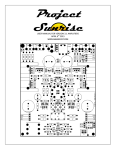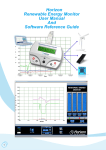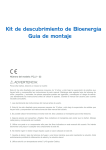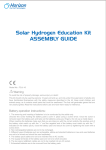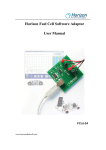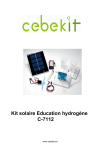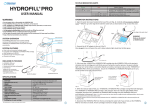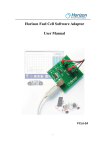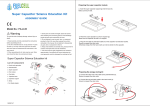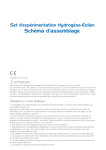Download Experiment manual
Transcript
wwww.cebekit.es Experiment manual Experiment manual Table of Contents: 1. General safety instructions Model No.: C-7112 Warning To avoid the risk of property damage, serious injury or death: This kit is intended only for use by persons 12 years old and up, and only under the supervision of adults who have read and understood the instructions provided in the kit’s user manual. Keep children under the age of 12 away as it contains small parts that could be swallowed. The Reversible Fuel Cell generates gases that are very easily ignited. Read the instructions carefully before use and have them ready for reference. 2. Discovering solar photovoltaic energy p1 p2 3. Introduction of the reversible fuel cell p4 4. About the solar hydrogen education kit 5. List of components p8 p9 6. Experiments p10 7. Advice for optimal use p24 8. Troubleshooting p25 Part 1. General safety instructions To avoid the risk of property damage, serious injury or death: 1. Read carefully and fully understand the instructions before starting assembly of this kit. 2. This kit is intended only for use by persons 12 years old and up, and only under the supervision of adults who have read and understood the instructions in this user manual. 3. When assembling this kit, tools may be used. Extra care should be taken to avoid personal injury. 4. Some parts are small and fragile: please be careful when handling and connecting parts to avoid breakage. Handle all parts and components with care. 5. Do not attempt to use any part, item, or component provided in this kit for any other purpose than what is instructed in this manual. Do not attempt to disassemble any part, item or component in this kit. 6. Empty all water, hydrogen and oxygen from each component after use. 7. Please read carefully the battery pack operation instructions on page 27 before using it. 1 Part 2. Discovering solar photovoltaic energy Creating electricity from sunlight: The Solar Hydrogen Education Kit contains a solar photovoltaic cell that will be used in most of our experiments as a way to capture renewable energy from the sun. The word “photovoltaic” is a marriage of two words: “photo”, meaning light, and “voltaic”, refering to Volts of electricity. So photovoltaic (pv) technology, involves the generation of electricity from light. The secret to this process is the use of a semiconductor material which can be adapted to release electrons, the negatively charged particles that form the basis of electricity. The most common semiconductor material used in photovoltaic cells is silicon, an element most commonly found in sand. All pv cells have at least two layers of such semiconductors, one positively charged and one negatively charged. When light shines on the semiconductor, the electric field across the junction between these two layers causes electricity to flow, generating DC current. The greater the intensity of the light, the greater the flow of electricity. Solar pv is quite different from a solar thermal system where the sun's rays are used to generate heat, usually for hot water in a house or swimming pools. 2 Part 3. Introduction of the reversible fuel cell The reversible fuel cell is very unique because it is both an electrolyzer and a fuel cell combined into one device. When applying an electric current, the device acts as an electrolyzer that produces hydrogen and oxygen from de-ionized water. When applying a load, the electrolyzer becomes a fuel cell and generates electricity from hydrogen. A. Fuel cell function of the reversible fuel cell: how does it work? A fuel cell is a device that can convert hydrogen to usable electric power. The fuel cell is an assembly of advanced material layers where hydrogen and oxygen react with each other to generate electricity and water, without any combustion. Costs for solar photovoltaic power generation are still high, but have decreased over the past 20 years. New generations of solar pv technologies are emerging as a result of new materials research. In the next years, we may see inexpensive solar pv materials printed like newspapers on rolls of flexible film. Flexible solar pv materials are already being “rolled-out” on the rooftops of warehouses, and some of these warehouses are now able to supply energy back into the local power grid during energy demand peaks. 3 Serious interest in fuel cells did not begin until the 1960's, when they were used as power for man’s first missions to the moon. Although fuel cells still provide electricity and water for today's space missions, this unique technology is now aimed at promoting a global transition to renewable energy sources. Fuel cell cars that use hydrogen as fuel are called "zero emission vehicles." If fuel cell cars were to use hydrogen produced by renewable sources of energy such as solar or wind power, our fuel supply would be unlimited - and consumption of hydrogen through fuel cells would not create any waste nor air pollution. 4 B. Electrolyzer function of the reversible fuel cell: how does it work? Electric Circuit e e e e PEM reversible fuel cell e e Fuel H2 (Hydrogen) 2H 2 e e magnified O2 (Oxygen) H2 O2 O O 2 H 2O Heat e- O Air + Water Vapor Used Fuel Recirculates Flow Field Plate Flow Field Plate Gas Diffusion Electrode (Anode) Gas Diffusion Electrode (Cathode) Catalyst Catalyst Proton Exchange Membrane 5 PEM reversible fuel cell (fuel cell function) side view Electrolysis is the use of electrical energy to produce a chemical change. In the renewable hydrogen cycle, electrical energy (from renewable resources) is used to break the bonds between the hydrogen and oxygen in the water, releasing them as elemental gases. Hydrogen is “stored“ renewable energy. An electrolyzer is a device that facilitates the electrolysis of water to produce hydrogen gas. Electrolyzers most commonly used today generate hydrogen at relatively low pressures (from nearly atmospheric pressure up to 200 pounds per square inch) and use a liquid alkaline electrolyte (KOH or NaOH). At these pressures, storage of large quantities of hydrogen requires extremely large storage vessels. One solution to this problem is to use a compressor to increase the hydrogen pressure. However, the energy investment required to pressurize hydrogen, as well as the maintenance of hydrogen compressors, makes this option difficult for a large-scale application of this technology. Furthermore, the operation of alkaline electrolyzers requires frequent maintenance that includes disposal and replacement of the highly caustic electrolyte. New approaches to water electrolysis include proton exchange membrane electrolyzers, which is the electrolysis function of the reversible fuel cell in this kit. Such an electrolyzer can be designed to electrochemically generate hydrogen at pressures of 2000 psi or greater, thus eliminating the need for mechanical compression. No caustic alkaline or acidic fluid electrolyte is required. Additional advantages of PEM electrolysis over alkaline electrolysis include lower parasitic energy losses and higher purity hydrogen output. PEM electrolysis is potentially a simple, sustainable, and costeffective technology for generating, compressing, and storing hydrogen. 6 Part 4. About the solar hydrogen education kit Magnified Proton Exchange Membrane (P.E.M.) Electrolyzer function O2 H2 The kit demonstrates chemistry and physics principles by experimenting with the splitting of water into its basic elements using direct renewable power generation from solar photovoltaic technology. Watch the initial process of electrolysis (See page 6 for more information on electrolysis) using the reversible fuel cell enabling hydrogen and oxygen to be produced and stored. Learn how hydrogen can be used as a renewable “energy carrier” that can power many applications via fuel cell technology. This kit provides an excellent opportunity to learn about the exciting prospects of renewable energy. See how renewable energy can be harnessed, stored, and re-used in all kinds of applications and how hydrogen can be the unique link between natural sources of power and power consuming devices using fuel cell technology. Enjoy this exciting science education kit, and start building your own hydrogen powered world! * The solar panel specifications: • Dimensions: 125mm x 155mm x 8mm • Voltage (at optimum power point) 2.2V D.C. • Current (at maximum power point) 450mA Note: Solar module data is based on standard conditions (1,000W/m2, 25°C) PEM reversible fuel cell (Electrolyzer function) Side View 7 Electrolysis using a Proton Exchange Membrane * The reversible fuel cell specifications: • Dimensions: 54mm x 54mm x 17mm • Total Weight: 69.7 grams * Electrolyzer function: • Input Voltage: 1.8V ~ 2.6V (D.C) • Input Current: ≥0.7A • Hydrogen production rate: 7ml/min at 1A • Oxygen production rate: 3.5ml/min at 1A * Fuel cell function: • Output Voltage: 0.6V (DC) • Output Current: 360mA • Power: 210mW 8 Part 5. List of components Part 6. Experiments A. Solar panel B. Double headed banana plug cable C. Reversible fuel cell D. Hydrogen tank E. Oxygen tank F. Gas containers G. Rubber tubes H. Water container base I. Hose pins J. Syringe K. Motor L. Battery pack M. adaptor N. Fan blade O. Reversible fuel cell base Sunlight powered water electrolysis using the electrolyzer function of the reversible fuel cell Insert the reversible fuel cell (C) into the slot located on the reversible fuel cell base (O) (see A). You will also need the following items (not included in this kit): - Scissors - 2 AA alkaline battery - Water* A C E F G I J K M * Distilled or purified water is highly recommended for optimal use. 9 B N D Use scissors to cut out two lengths of 2cm of rubber tubing from the long rubber tube (G) provided in the kit. Place the black pin (I) into one end of the 2cm rubber tube. H Attach the short rubber tube with the black pin to the top nozzle on the hydrogen side of the reversible fuel cell (marked H2). Attach the other short rubber tube to the top nozzle on the oxygen side of the reversible fuel cell (marked O2) and place the red pin (I) aside (see B). L O A B C Note: Good ion conductivity is critical to the performance of the reversible fuel cell. In order to ensure good conductivity, the reversible fuel cell’s membrane needs to be properly humidified. In order to humidify the reversible fuel cell, complete the following three steps: Find the syringe (J) and push in its plunger in to remove all air inside. Draw distilled water into the syringe. On the reversible fuel cell (C), insert firmly the syringe (J) nozzle into the upper nozzle tube on the oxygen side. Slowly push the plunger to let the water into the oxygen side of the reversible fuel cell (see C). 10 Stop pushing on the plunger once the water starts to come out from the chamber of the reversible fuel cell (C). Disconnect the syringe (J) from the nozzle tube and attach the red pin to the tube. Let the reversible fuel cell settle for 3 minutes. Place the water container base (H) with the Horizon logo facing towards you. Insert the hydrogen outer storage containers (D) into one of the round slots located on the water container base (H) (see D). Use scissors to cut out one 16cm long tube. Connect one end of this tube to the nozzle of the inner hydrogen container (see G). Connect the other end of this tube to the lower nozzle on the hydrogen side of the reversible fuel cell (see H). Insert the oxygen outer storage containers (E) into the other round slot on the same base (see E). Insert the two inner containers (F) into the hydrogen and oxygen outer containers (D & E) (see E & F). D E F Note: There are two openings at the bottom of each of the inner containers (F). These openings allow for gas to escape the inner containers (F) into the outer containers to limit the amount of gas stored. Make sure these openings are not blocked by the raised plastic frame holding the inner containers (F). Push on the top of the inner containers (F) to be sure they fit firmly onto the plastic rim located at the bottom of the outer storage containers. 11 G H 12 Use scissors to cut out another 16cm long tube. Connect one end of this tube to the top nozzle of the inner oxygen container. Connect the other end of the tube to the lower nozzle located on the oxygen side of the reversible fuel cell (see I). Pour about 40ml distilled or purified water into the outer hydrogen and oxygen containers respectively (reach upper 20 marks on the outer container - see J). Disconnect the red pin of the short tube on the oxygen side of the reversible fuel cell (see K). You should observe that water fills the inner container. Once it is full, connect the red pin back onto the short tube. Repeat the same step on the hydrogen side. If the water cannot flow into the inner container please see Note on page 11 to solve the problem. K Use the solar panel to turn solar energy into hydrogen L Connect one end of the red and black cables (B) to the solar panel (A). I J Note: The water filling container is not provided in this set. You can use any other water container, but make sure the container you use is clean. Connect the other end of the cables to the reversible fuel cell (C) being careful to match up red plug with red socket and black plug with black socket (see L). If you cross the wires, or do not connect these cables correctly, the reversible fuel cell (C) could be permanently damaged. Position the solar panel in the face of strong sunlight outside. Look closely at the reversible fuel cell (C), you will notice water is slowly being displaced. 13 14 These changing water levels show that gases are formed inside the containers: hydrogen is being produced on the negative side or “cathode” of the fuel cell, and oxygen is being produced on the positive side or “anode” of the fuel cell. The hydrogen produced will be twice the volume of the oxygen produced. The hydrogen production cycle is complete when bubbles start surfacing from the inner container. When bubbles start to appear, disconnect the solar panel from the reversible fuel cell. Activities: Measuring the hydrogen and oxygen production Gas volumes produced and ratios Volume of Hydrogen (ml) Volume of Oxygen (ml) Ratio (Hydrogen to Oxygen volume) 10 15 20 25 30 35 40 45 50 Goal of this experiment: Students will establish that hydrogen and oxygen are produced at a 2:1 ratio. 15 Find the battery pack (L) and make sure the power switch is in the “off” position. Use a screwdriver to open the empty battery pack and insert 2 AA batteries into the casing, then close the lid by replacing the screws onto the battery pack. Connect the red plug of the battery pack (L) to the red input jack of the reversible fuel cell (C). Connect the black plug of the battery pack (L) to the black input jack of the reversible fuel cell (C). Make sure this connection is absolutely correct. Any other connection will permanently damage your reversible fuel cell module (see picture below). Reversible fuel cell (electrolyzer function) data recording chart Time (min) Using the battery pack to perform electrolysis (in case of no sunlight) Turn the battery pack (L) on, and watch closely as water is displaced in the water tanks (D & E) and small bubbles start appearing. You will notice that they appear faster than by using the solar panel, as the output power of the battery pack is higher than that of the solar panel. Note: Read the battery pack operation instructions on page 27 carefully before use. 16 You will know the hydrogen container is full when bubbles start overflowing into the main water tank. Build your own fuel cell application Once hydrogen production is completed, power off the battery pack. Once the hydrogen gas container (F) is filled with hydrogen there is now a stored energy source available to power applications using the fuel cell function of the reversible fuel cell (C). The reversible fuel cell (C) will act as a H2/O2 fuel cell to power small applications. See the following experiment as an example. Disconnect the red and black cables from the reversible fuel cell, and place the battery pack aside. In the next experiment we use this battery generated hydrogen to supply this reversible fuel cell and power a small electric fan. 17 Take the small plastic adaptor (M) out of its packaging. Position the small hole to the motor axis and connect the adaptor to it. Make sure the adaptor is inserted all the way onto the base of the axis (see pictures below) and that the motor can rotate freely. 18 Position the motor axis with the adaptor to the fan blade. Connect the fan blade to the adaptor. Make sure the fan blade is firmly secured to the adaptor. Make sure the fan blade can rotate freely. Disconnect the red & black cables from the solar panel. Connect the red cable connected to the reversible fuel cell to the red female plug on the motor cable. Connect the black cable connected to the reversible fuel cell to the black female plug on the motor cable. Make sure all the connections are correct. Holding the motor, you can now see the blue fan spinning quickly, consuming the hydrogen and oxygen stored in the inner gas containers (see picture below). Note: If the fan blade stops running while there is still hydrogen remaining in the inner gas container, this implies the hydrogen is not pure in the container and tube and can not be consumed completely. You can unplug the black pin on the hydrogen side of the fuel cell and quickly attach the pin back into the tube. You can then see the fan running again (for more detailed information see page 21). Once there is no more hydrogen gas left in the inner container, no more electricity can be produced, and you will see the fan blade running slowly until it stops. Disconnect the red & black cable from the motor. To create more hydrogen and oxygen repeat the process starting on page 14. 19 20 Maximizing hydrogen utilization and optimizing application run-times There will be some nitrogen in the system and you will have to get rid of it to make your applications work. In order to maximize hydrogen utilization, the key is to avoid having air (nitrogen) inside your hydrogen fuel cell system. In order to achieve this goal, we must operate several steps. Make sure you have your reversible fuel cell module and hydrogen storage modules connected to each other and there is still hydrogen left in the inner hydrogen container. The load is connected to the whole system. Create your own fuel cell powered application! Using your thumb and index finger, strongly pinch the short tube located on the reversible fuel cell (C) so that no air passes through the tube. Keep pinching the tube. Use the hydrogen and oxygen storage system to power the applications of your imagination. You can remove the fan blade from the motor and use this motor as your mechanical drive. Remember to keep your power requirements low as this will reduce the drain on hydrogen. Feel free to submit pictures and comments on your application developments to [email protected] for our feedback. While you keep pinching the tube, remove the black plastic pin (see picture A). Very slowly decrease pressure on the tube between your fingers. There will come a point where gas will start coming out (and very quickly!). As you do this, keep looking at the hydrogen in the hydrogen tank to make sure you don't release too much. Be quick and agile enough to release just a very tiny amount of gas and pinch the tube back again quickly to keep the maximum gas in. A Additional Experiments: You can use Horizon Fuel Cell Software Adaptor FCJJ-24 (not included) to visualize experiments on you screen or to measure the fuel cell performance before and after the hydrogen purging process to have a clear view of the impact of this process on the fuel cell. Also you can use Horizon Fuel Cell Software Adaptor FCJJ-24 to perform your additional experiments. Keep pinching the tube as you replace the black plastic pin. Once the pin is back on the tube, you can let go (see picture B). The load should work better than before due to some impure gases having been removed. 21 Note: 1. You can use Horizon Fuel Cell software Adaptor FCJJ-24 to measure the fuel cell performance before and after the hydrogen purging process to have a clear view of the impact of this process on the fuel cell. 2. You can conduct the hydrogen purging process at any time if the load stops working while the hydrogen still remains in the container. 3. If the fuel cell is used for the first time to power a load it is highly recommended to follow the hydrogen purging process as on page 21. B You can purchase the Horizon Fuel Cell Software Adaptor FCJJ-24 at http://www.horizonfuelcell.com/store.htm and following instructions on the site. 22 ! 1. As the reversible fuel cell keeps producing hydrogen and oxygen, its membrane becomes slightly warm. It is advised not to produce hydrogen and oxygen continuously for more than 10 minutes at a time or the reversible fuel cell will be permanently damaged. 2. After the reversible fuel cell produces hydrogen and oxygen continuously for nearly 10 minutes, disconnect it from its power source. Inject some distilled or purified water into the oxygen side of the reversible fuel cell to humidify the membrane for about 3 minutes (see page 10). 1. Make sure you use distilled or purified water only. Any other water will contain substances and minerals that can contaminate and destroy the reversible fuel cell. If you notice the fuel cell starts rusting – it means the appropriate water (distilled or purified water) was not used for your experiments. 2. Make sure the reversible fuel cell is well hydrated before any electrolysis operation by filling it with water using the syringe. 3. During electrolysis, make sure the hydrogen and oxygen tubes that connects the hydrogen and oxygen supply containers to the reversible fuel cell are not clinched. Otherwise the accumulated hydrogen and oxygen pressure will puncture and damage the reversible fuel cell’s membrane. 3. You will have maximum performance when the entire electrolysis process is repeated three to four times. This is due to the increased hydration of the PEM membrane in the reversible fuel cell after repeated use. Optimal temperature: 20°C - 30°C. Make sure the outer containers are filled with purified distilled water to the top 20 mark on the outer containers before proceeding with electrolysis. 4. Using non-distilled water will damage the electrodes of the fuel cell. Fuel cells use nano-scale or carbon supported platinum as a catalyst, and these particles are very sensitive to impurities found in non-distilled water. It is highly recommended to use the distilled or purified water. 4. Ensure that the small outlets on the inner containers are not blocked by the plastic rim on the bottom of the outer container. Hydrogen and oxygen are lighter than water so they flow to the top of the inner container, displacing the water. If these small holes are blocked, too much pressure will build up inside reversible fuel cell and this will cause damage to the reversible fuel cell. 5. For the purpose of this solar hydrogen education kit, high quality drinking water or tap water with low mineral content can also be used - however the kit’s lifetime will be shortened. 6. The reversible fuel cell must ONLY be hydrated through the oxygen (positive side) and not through the H2 side, failure to do so will result in the blockage of the hydrogen flow and failure of the experiments. 7. Carefully read the battery pack operation instructions before use. 23 Part 7. Advice for optimal operation 5. When you run the reversible fuel cell multiple times, water in the upper part of the outer container might not descend to the inner container. This is because a vacuum has been created in the tubing. Disconnect the tubing from the upper nozzle of the reversible fuel cell and the water will descend into the inner container appropriately. 6. The reversible fuel cell in the open air is very sensitive to volatile organic compounds, which will affect the performance of it. So when you finish using the kit, it is highly recommended to place the reversible fuel cell inside an air-sealed plastic bag, such as a “Ziploc” bag. This will protect the reversible fuel cell while you are not using your kit. 24 Part 8. Troubleshooting 1. The water levels do not drop when the gas outlet tubes on both sides of the reversible fuel cell are unplugged. Solution: Check whether the holes on the wall of the inner cylinder are blocked. If so, turn the inner cylinder until water enters the holes and fills up the inner cylinder. 4. The load can not work while there is hydrogen left in the inner container. Solution: Unplug the black pin of the short tube on the reversible fuel cell and quickly attach the pin back to the tube (see page 21). You can see the load working well again. 2. The reversible fuel cell does not produce hydrogen and/or oxygen. 5. No hydrogen is produced under the sunlight. Solution 1: Check whether the wires are appropriately connected, and whether there are any loose connections. The reversible fuel cell could be completely destroyed if the red wire of the battery pack is connected to the black jack of the reversible fuel cell. Solution: If the sunlight is not strong enough electricity will not be created. Use the battery pack provided to perform the electrolysis using the reversible fuel cell. Solution 2: Make sure the batteries are inserted with the correct polarity. Solution 3: Replace the old batteries with new one in the battery pack. 3. The water electrolysis process slows down. Solution 1: Inject water to the oxygen side of the reversible fuel cell by using the syringe and wait for about 3 minutes. Solution 2: Replace the old batteries with new one in the battery pack. If you have any further issues contact [email protected] 25 26 Battery pack operation instructions: ! 1. The removing and inserting of batteries is to be conducted by the adults only. Unscrew the screw holding the battery pack’s cover in place using a screw driver. Once the screw is removed open the battery pack and take out the batteries using your fingers. Do not use a metal object. When inserting the batteries make sure that you are doing so with the correct polarity (the positive end of the battery must match up with the “+” and the negative end of the battery must match up with the “-” sign indicated on the battery pack), close the battery pack and secure its cover by tightening the screw with a screw driver. 2. Non-rechargeable batteries are not to be recharged. 3. Different types of batteries such as rechargeable, alkaline and standard batteries or new and used batteries are not to be mixed and should be used separately. 4. The battery pack cables are not to be inserted into an AC socket. 5. The supply terminals of the battery pack are not to be short-circuited. 6. The two spare red & black cables are not to be inserted into an AC socket. 7. Exhausted batteries are to be removed from the battery pack. 27
















